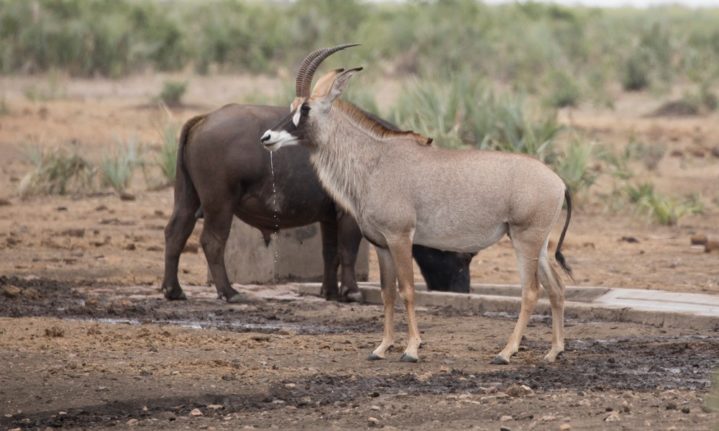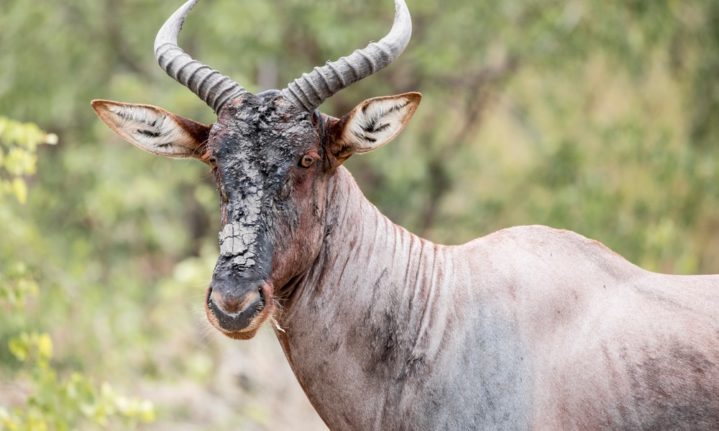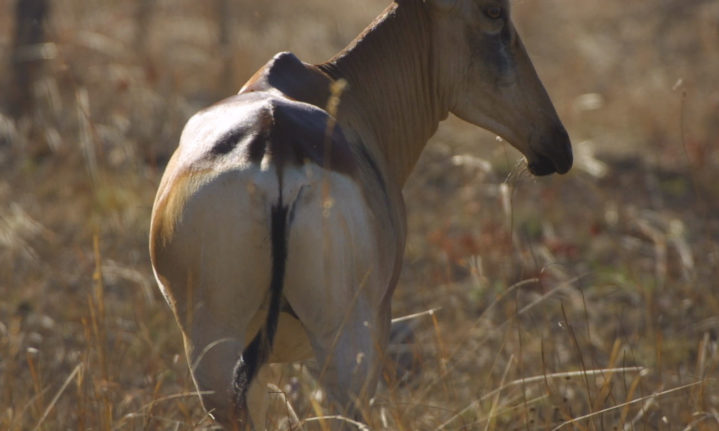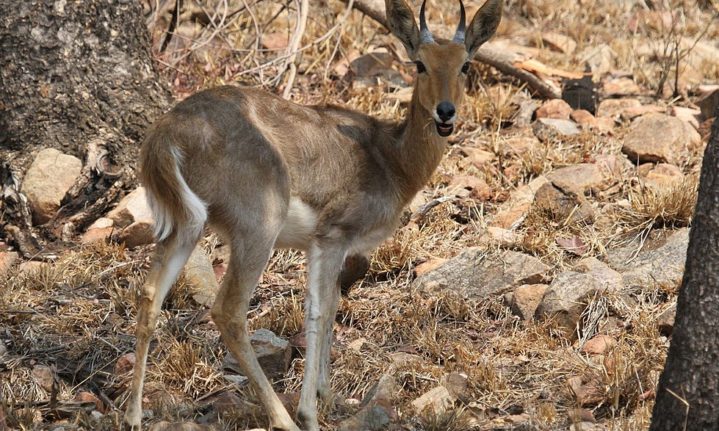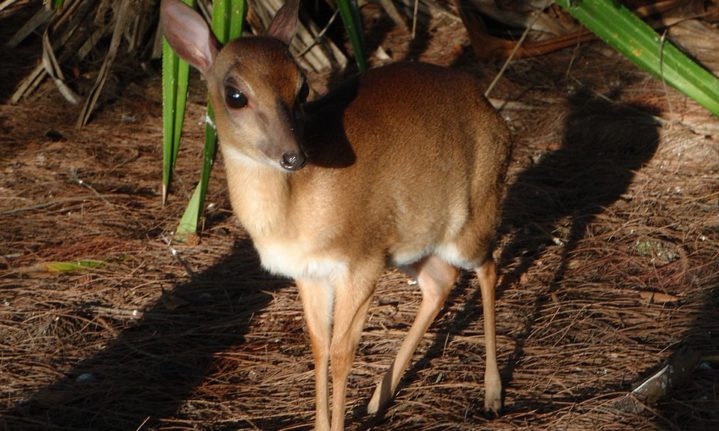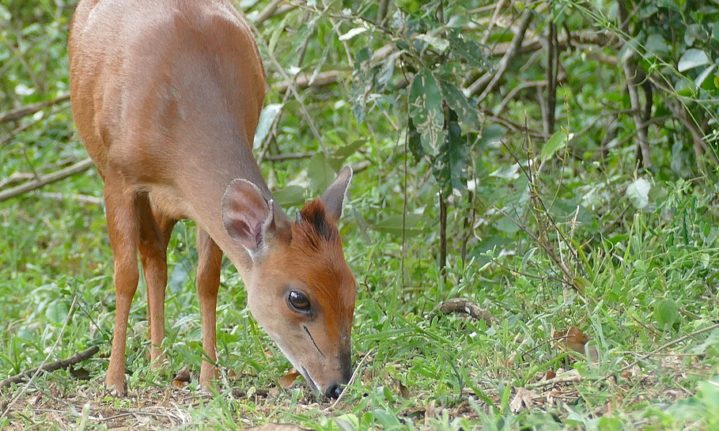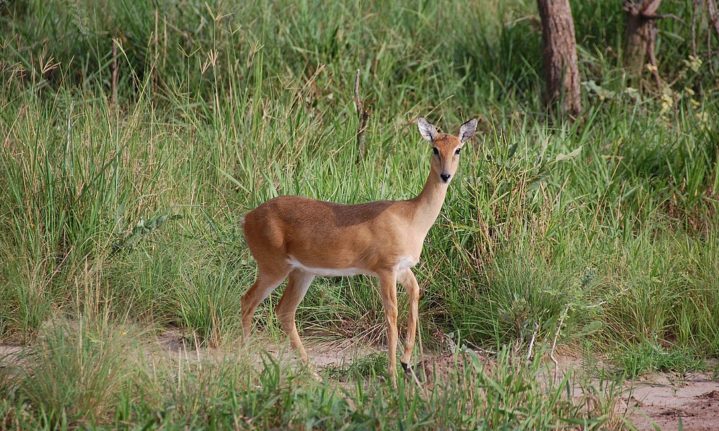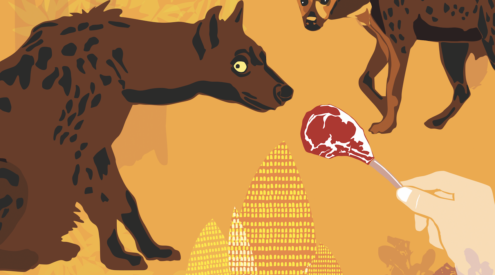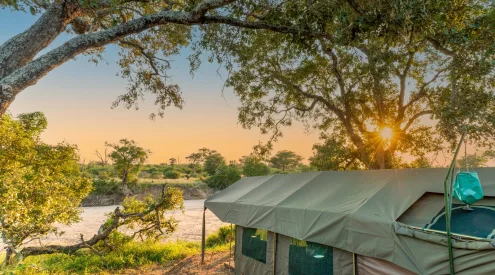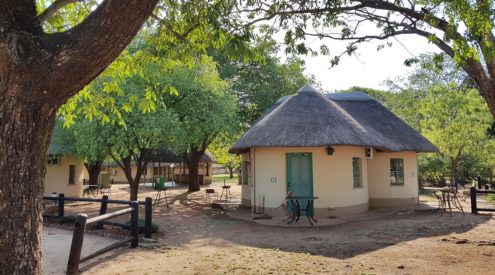On a trip to Kruger, sightings of antelope are very common. Visitors are guaranteed sightings of common antelope like impala, kudu, nyala and waterbuck, but some species remain so elusive, it’s even easier to spot a leopard than some of these hoofed animals. There are 21 species of antelope in Kruger, but these are the 10 that would make a very special and rare sighting.
1) Oribi (Ourebia Ourebi)
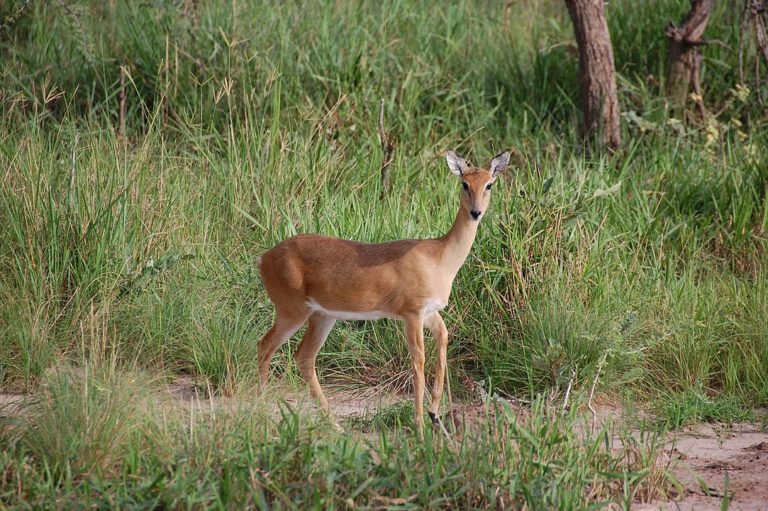
Photo: Noel Reynolds
The oribi is a small antelope, rarely seen in the park. They stick to savannahs as they prefer short grasses to graze on, and avoid areas dominated by dense bushes and trees. Oribis have long necks and slender legs, with short bushy tails and a white underbelly. Males have thin straight horns that reach around 16 cm. Distinguishing features of these little antelopes are the crescent-shaped patch of white fur just above the eyes, and a black patch just below each ear. They can reach speeds of up to 50km/h for a short burst of time when trying to escape a predator. When surprised by a predator, oribis may practice “slotting,” jumping vertically with straightened legs and an arched back. Oribis are often found in pairs, but unlike other small antelope they are sometimes found in groups of three, with one male and two females making up the group.
2) Suni (Neotragus moschatus)
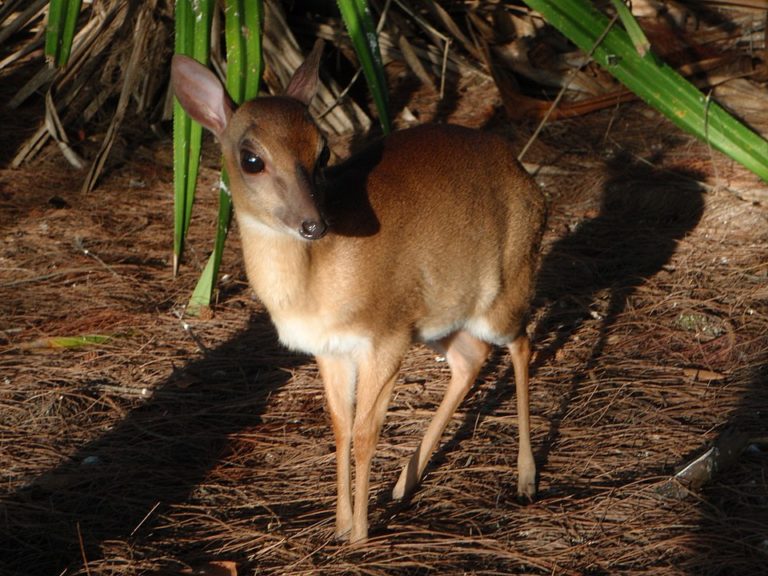
Photo: Olivier Lejade
The tiniest of Kruger’s antelope, the Suni is mostly found in the northern parts of the park but is extremely rare to see. This antelope, weighing in at only around 5kg is a shy animal with reclusive habits. Sunis are vulnerable to predators like African rock pythons and big birds of prey and raptors. They tend to be more active at night and spend the day resting in sheltered areas. These tiny antelope feed on leaves, fungi, flowers and fruits that fall from trees.
3) Common reedbuck (Redunca arundinum)

Photo: Bernard Dupont
Despite the name, there’s nothing common about them! Reedbuck are found mostly in the northern regions of the park, near Mopani rest camp and upwards. Also sometimes called southern reedbucks, these antelope prefer long grass to graze on, and can be found in woodlands or savannahs and floodplains. Reedbuck are territorial, and tend to be found in small groups of about six to eight individuals, but may join up with other groups in the dry season. There are only an estimated 300 common reedbuck in Kruger. Rams have short, forward facing horns, and can weigh up to 68kg, while ewes weigh about 50kg. Common reedbuck make a range of vocalisations, from high pitched whistling to snorting sounds particularly when distressed.
4) Southern Mountain reedbuck (Redunca fulvorufula)

Photo: Derek Keats
Mountain reedbuck appear similar to their common cousins, but are considerably smaller, which suits their mountainous habitat better. Mountain reedbuck are divided into three subspecies, of which the Southern Mountain reedbuck is the most common. They prefer rocky areas and tend to gather in small herds like common reedbuck, but are more territorial and show this by snorting at would-be intruders. Mountain reedbuck also whistle when they feel threatened, and continue to whistle even as they flee predators, unlike the common reedbuck who snort when pursued. Unlike impala, reedbuck tend to hide their young in long grass and sheltered areas for the first few weeks after they are born to keep them hidden from predators. The latest game count estimated only 150 individuals in Kruger, making sightings extremely rare.
5) Tsessebe (Damaliscus lunatus)

Photo: Anton Crone
One of the stranger looking antelopes in Kruger, the Tsessebe is also one of the fastest, reaching speeds of up to 80km/h. Tsessebes favour open Savannah grasslands and are sometimes seen in the central plains of Kruger, but are mostly seen near Mopani rest camp and further north. In Kruger these antelope are found in small herds, but in Zimbabwe, Zambia, Tanzania and parts of Kenya they can be found in large herds and display different social behaviour. Tsessebe cows are only in heat for 1- 1,5 days, and give birth to a single calf. Both cows and bulls have horns, and often cover them in mud during the rainy season. There are only around 220 tsessebe in the park as per the latest census. Tsessebe seem to not be a favoured prey among predators, possibly owing to their size (males weigh up to 150kg) and speed, and will behave aggressively toward smaller predators like lone hyenas or jackals threatening their young. Tsessebe often have termite mounds within their territory, which they use to get an elevated position to look out for danger or intruders.
6) Roan antelope (Hippotragus equinus)
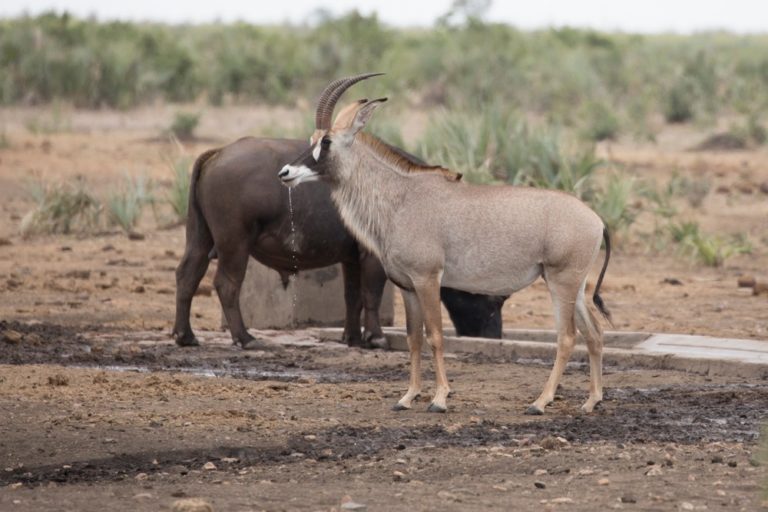
Photo: Anton Crone
Roan antelope are some of the largest antelope in Kruger, with bulls reaching up to 300kg. But despite their size, they’re not easy to spot. With under 100 individuals in Kruger, the chances of seeing them are much smaller than the chances of seeing a leopard (around 1000 individuals in Kruger). They are found in woodland, grassland and savannah areas in Kruger, usually from the mid region of the park to the northern region. Roan have distinctive long curled black horns (both males and females have horns) and a black and white face, and are sometimes confused with similar looking but much darker, sable antelope. While sable are also very rare, there are more sable than roan in Kruger. At one point, roan numbers had declined so dramatically in the park that management set up a roan breeding camp in the north-west corner of Kruger in an attempt to revive the population. Sadly, 20 of 29 roan died of dehydration in this camp in 2019. This was a huge blow to Kruger’s roan population, which has been on the decline for decades, with around 450 individuals in 1986 down to fewer than 30 animals in 2003. Unlike sable, roan breed all year round giving birth to a single calf after a gestation time of nine months, and hide their young long grass for the first few weeks of life.
7) Grey Rhebuck (Pelea capreolus)
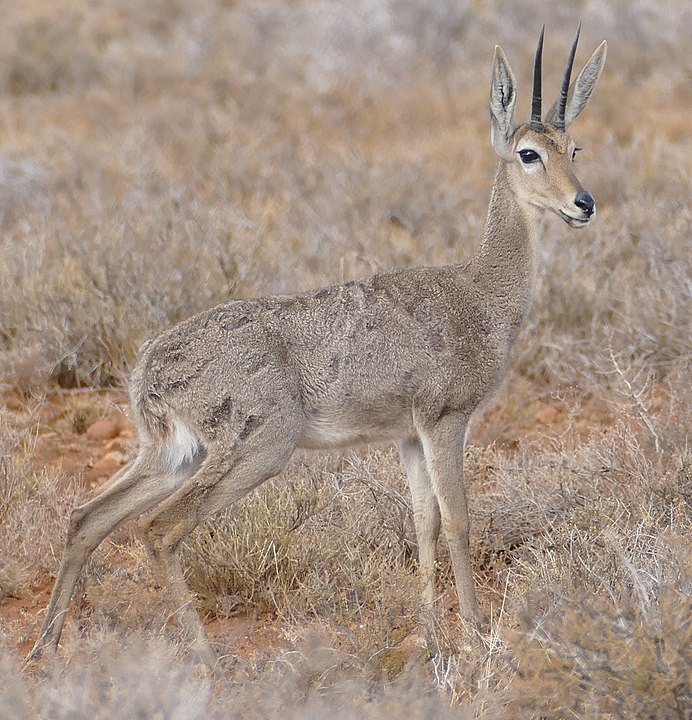
Photo: Bernard Dupont
This small antelope is very seldom seen in the Kruger. They are more associated with Western Cape reserves, but a few of these little fellows do live up north! (Grey rhebuck are also found in the Eastern Cape, Mpumalanga, Free State and in parts of the Drakensberg.) Rhebuck (Reebok in Afrikaans) have been known to graze, although they mostly browse, and are found on grassy slopes and mountainous areas. They are often mistaken for mountain reedbuck, but the horns are a tell-tale difference as the rhebuck’s horns stick straight up and parallel, while the reedbuck’s horns curve forward. Rhebucks are polygynous, grouping themselves into herds that usually consist of one dominant male, and up to 12 ewes and their lambs. These antelope rely on their sight, and it is estimated that they can see between 200-400m away.
Did you know?
This antelope is the inspiration behind the international sportswear brand Reebok, after the company founder’s grandsons found the name in a South African dictionary in 1958.
8) Red Duiker (Cephalophus natalensis)
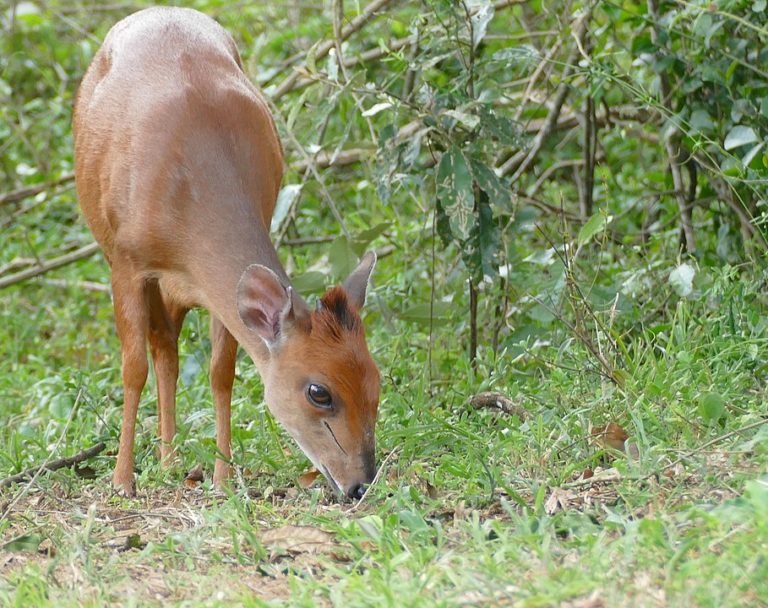
Photo: Bernard Dupont
Far less common than their grey cousins, (now called the common duiker) the red duiker is a very rare sighting in the Kruger. They are unlikely to be confused with the grey or common duiker, as they are much smaller and reddish in colour. Both males and females have short straight horns, unlike the grey duiker where only the males have horns. Red duikers have a hunched appearance, with their front legs shorter than their back legs. These longer hind legs allow them to spring into action quickly if necessary. They are most active during the day, foraging for leaves, fallen fruits and flowers, and tend to stick to dense vegetation which is why they are so seldom seen.
9) Sharpe’s grysbok (Raphicerus sharpei)
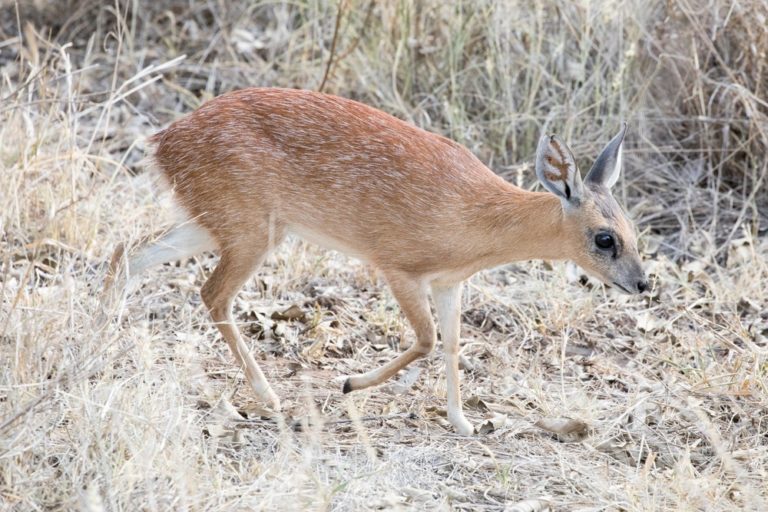
Photo: Anton Crone
Belonging to the same family as the steenbok, Sharpe’s grysboks are a kind of dwarf antelope not often spotted in Kruger. They prefer a fairly dense habitat, allowing them to hide in the foliage, and are very territorial. They are solitary animals, but will make brief associations when mating. Also sometimes confused with grey duikers, the Sharpe’s grysbok has a reddish coloured coat, with grey flecks especially on the rump. They have distinctive dark rings around the eyes and dark colouring on the inside of the ear, like the veins of a leaf. Like most small antelope, when threatened by predators Sharpe’s grysboks will first hide, staying very still in thick foliage or even burrows, until they may be forced to flee.
10) Lichtenstein’s Hartebeest (Alcelaphus lichtensteinii)

The Lichtenstein’s hartebeest is one of eight subspecies of hartebeest, and the only subspecies that occurs in Kruger. They are grazers, preferring open grasslands and areas close to water, and like the tsessebe use termite mounds to gain an elevated view of their territory. They group themselves in small herds of about 10 individuals, led by a dominant and territorial bull. Both bulls and cows have their signature s-shaped curly horns, which bulls sometimes use to mark their territory by rubbing them in the ground. Calves are generally born between August and September.
ALSO READ










